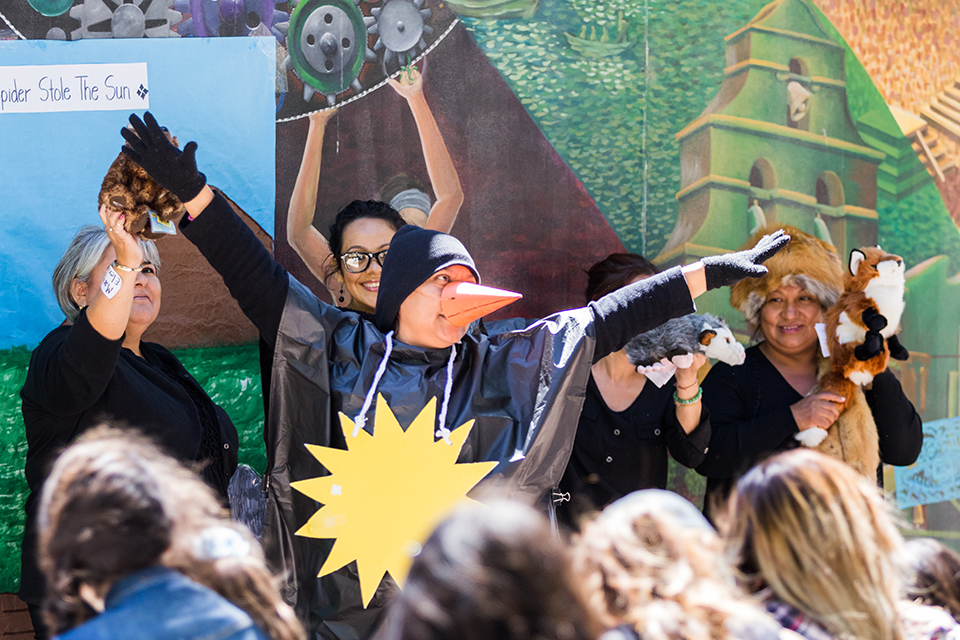Exhibition Highlights ‘Climates of Inequality,’ Work by CSUN Faculty & Students

Members of the San Fernando Valley-based Padres Pioneros at their annual Family Literacy Festival in 2019. CSUN faculty and students have worked closely with Padres Pioneros on environmental education and justice issues. Those efforts are featured in national touring exhibition, “Climates of Inequality,” on display, first, at the Japanese American National Museum and then at the Riverside Art Museum. Photo courtesy of Alonso Garcia.
Communities of color are often the first and most impacted by the human decisions that contribute to climate change. They are also the places where the foundations for environmental justice can be found, according to California State University, Northridge Chicana/o studies professor Stevie Ruiz.
Ruiz is part of a team of academic and nonprofit leaders who have organized a national touring exhibition that shares how local environmental histories are intertwined with movements for racial, immigrant and labor rights, as well as equitable access to affordable housing, clean air and green space.
The exhibition, “Climates of Inequality: Stories of Environmental Justice,” will make back-to-back stops in Southern California. It opens first at the Japanese American National Museum in downtown Los Angeles from Sept. 24 through Oct. 1, and then from Oct. 14 through Nov. 5 at the Riverside Art Museum in Riverside.
“So many of the stories the exhibition showcases illustrate how partners in communities of color are setting the model for how to incorporate cultural traditions and knowledge into the environmental justice movement,” said Ruiz, who teaches in CSUN’s College of Humanities. “They are stories that many in the environmental movement don’t know. They are also the stories of how immigrant communities bring with them traditions and practices, steeped in history, that can teach us so much about dealing with the impact of climate change.”
The exhibition combines virtual reality, audio testimony and historical imagery to delve into the deep roots of climate inequality and environmental injustice. In addition to stories drawn from communities across the United States, Mexico and beyond, two local narratives will be on view.
The first, “Reimagining Immigrants and Environmental Justice,” is a collaboration between CSUN students, students from the University of California, Santa Barbara, and the San Fernando Valley-based community organization Padres Pioneros. The second, “Witnessing the Slow Violence of the Supply Chain,” is a collaboration between students and faculty from the University of California, Riverside, and the People’s Collective for Environmental Justice. Both collaborations are part of a coalition of universities and community organizations led by the Human Action Lab at Rutgers University, Newark.
On Saturday, Sept. 30, the Japanese American National Museum will host a daylong “Climates of Inequality Symposium” inspired by the exhibition. The event, which starts at 9 a.m., will feature conversations with environmental justice leaders from throughout Southern California who will discuss how their communities mobilize storytelling for change and to save lives.
Ruiz will be moderating a panel discussion, “Organizing for Environmental Justice in Southern California,” featuring CSUN Chicana/o studies professor Rosa RiVera-Furumoto. RiVera-Furumoto and members of Padres Pioneros; Alicia Aguayo of the People’s Collective for Environmental Justice; Amy Honjiyo of Sustainable Little Tokyo; and Nalleli Cobo of People Not Pozos.
The day will also include the panel discussion “Shifting the Narrative: Environmental Justice and the Place of Public Humanities,” a self-guided tour of the Climates of Inequality exhibition and a screening of the film “Manzanar, Diverted: When Water Becomes Dust” as well as a discussion with its filmmaker.
The symposium is free, but registration is required. To make a reservation, visit the website https://www.janm.org/events/2023-09-30/climates-inequality-symposium.
For more information about the exhibition and its public programs, visit www.janm.org and www.riversideartmuseum.org. Read about “Climates of Inequality” at https://climatesofinequality.org.
The Japanese American National Museum is located at 100 N. Central Ave. in Los Angeles. The Riverside Art Museum is located at 3425 Mission Ave. in Riverside.

 experience
experience